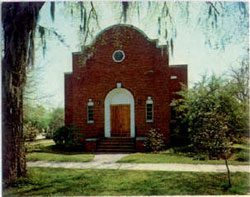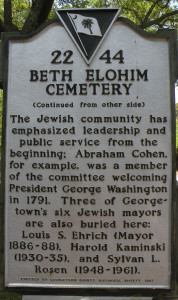History of Temple Beth Elohim
Corner Screven and Highmarket Streets
Georgetown, SC
Temple Beth Elohim Cemetery, Founded 1772
 Jews arrived in the historic seaport of Georgetown, S.C. in the mid 1700s and by 1800, were a small but important portion of the population. Two of the first to arrive were brothers Abraham and Solomon Cohen. Along with Mordecai Myers, these gentlemen were some of the founders of the early mercantile business in Georgetown. Each in turn, also became a postmaster of Georgetown. By 1800, the Solomons and Mordecai Myers were joined by Myers’ sons, Levi, Abraham, Jacob and Moses. Although proportionally only 10% of the white population, Jews held a disproportionately large role in civic life. Before the beginning of the 20th century, there had been 5 Jewish intendants – or mayors – of the city: Solomon Cohen, Abraham Myers, Aaron Lopez, Solomon Cohen, Jr., and Louis Erlich. In the recent 20th century, Sylvan Rosen was the 6th Jewish mayor of Georgetown. His brother Meyer Rosen still practices law at his office on Screven Street.
Jews arrived in the historic seaport of Georgetown, S.C. in the mid 1700s and by 1800, were a small but important portion of the population. Two of the first to arrive were brothers Abraham and Solomon Cohen. Along with Mordecai Myers, these gentlemen were some of the founders of the early mercantile business in Georgetown. Each in turn, also became a postmaster of Georgetown. By 1800, the Solomons and Mordecai Myers were joined by Myers’ sons, Levi, Abraham, Jacob and Moses. Although proportionally only 10% of the white population, Jews held a disproportionately large role in civic life. Before the beginning of the 20th century, there had been 5 Jewish intendants – or mayors – of the city: Solomon Cohen, Abraham Myers, Aaron Lopez, Solomon Cohen, Jr., and Louis Erlich. In the recent 20th century, Sylvan Rosen was the 6th Jewish mayor of Georgetown. His brother Meyer Rosen still practices law at his office on Screven Street.
The Jews of Georgetown worshipped in each other’s homes and also at the Winyah Indigo Society. By 1904, the congregation of Beth Elohim – a sister congregation to Charleston’s K.K. Beth Elohim – was formally organized. There were over 100 members at that time. Temple Beth Elohim was incorporated in 1921 and the present temple was built in 1949. For over half a century, the congregation enjoyed the services of visiting rabbis from Charleston’s Kahal Kadosh Beth Elohim, among them, Rabbi Barnett Elzas and K.K.B.E.’s longest serving rabbi, Rabbi Jacob Raisin.
The Beth Elohim cemetery, located on the corner of Broad and Duke Streets was established in 1772 and is the second oldest Jewish burial site in the state. It contains the graves of three of Georgetown’s six Jewish mayors.
“The Jewish cemetery at Georgetown is the second oldest Jewish cemetery in South Carolina, and contains a number of inscriptions of historical interest. I have not been able to trace its history owing to the fact that the records in Georgetown prior to the War are no longer in existence.” The Jewish Cemetery at Georgetown, S. C. Compiled By Barnett A. Elzas S, M. D. LL. D. Charleston. S. C. 1910.
The last 50 years have seen a marked change in Jewish life in South Carolina. While Jewish communities are flourishing in cities such as Columbia, Charleston, Hilton Head and Myrtle Beach, they are struggling to hold on in the smaller towns. Some Jews say that their co-religionists have succeeded far too well in becoming ‘a portion of the people.’ Intermarriage and migration to bigger cities and more promising careers have taken a toll.
Five faithful members of the founding families: Alwyn Goldstein, Meyer Rosen, Rita Fogel, Philip Schneider, and Debbie Abrams continued to hold services, although abbreviated, every Friday night. Beth Elohim had even given away one of its Torahs and was considering closing its doors and selling the building. With an influx of new people to the Grand Strand, there has been a growth in the Reform community and a need to be fulfilled. There is now a community of 40 families who are involved in the congregation. Services are held every Friday night with 20-30 in attendance. There is a full Torah service every Friday Night and an Oneg (social function) after services on the 2nd and 4th Fridays of the month (except June, July, and August). Much work has been done on the buildings and grounds, and to the interior.
2009 is the 60th anniversay of the Temple Beth Elohim building. A re-dedication ceremony will commemorate the 60th anniversary of the synagogue building. A Tree of Life was erected in honor of the families of 1949 who worked so hard to build our synagogue
Most of the information on the early Jewish presence comes from the book, Shared Traditions; Southern History and Folk Culture by Charles Joyner.

